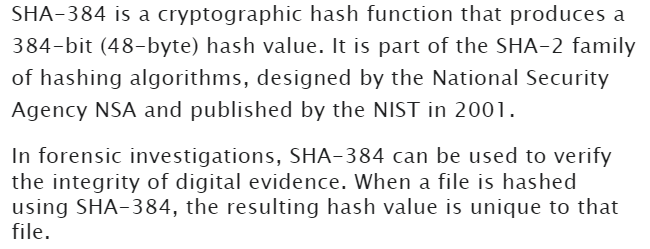Hashing Tools are Vital-Week 4: Hashing Tools are Vital to Computer Forensics (Required/Graded)
Hashing is when a mathematical algorithm is applied to digital data and it is critical to forensic evidence collection and validation. Some of the most commonly used hashes are the Message Digest 5 hash (MD5) and Secure Hashing Algorithm (SHA-1). The MD5 hash is a 128-bit hexadecimal value, and the SHA-1 hash is a 160-bit hexadecimal value. A hexadecimal number contains all of the numbers 0-9 and letters from A-F, with A representing the number 10 and F representing the number 15 (0-F is 16 digits). Here is an example of an MD5 hash: 2FBB61AF3038AA31DC29977FF077344A. There are other hashes used for verification including SHA-256, SHA-384, and SHA 512, which are 256-bit, 384-bit, and 512-bit hexadecimal values.
Use and discuss one of the hashing tools that can be used in Windows or Kali Linux in MARS.
md5sum (Linux)
sha1sum (Linux)
HashTab (Windows)
Hashcalc (Windows)
sha224sum (Linux)
sha512sum (Linux)
sha384sum (Linux)
sigcheck (Windows)
If someone on your team has already picked one of the above tools, pick a different Windows or Linux tool from MARS.
Answer Preview-Hashing Tools are Vital- Computer Forensics-CST 640

